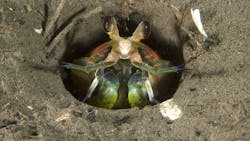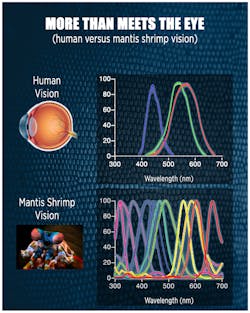Engineers at the University of Illinois took a clue from the mantis shrimp when they developed a camera for helping surgeons identify tumors in patients. The shrimp’s eyes can discern up to 12 different colors, including some in the IR range, thanks to stacks of light-sensitive cells that make up the sensing part of the shrimp’s eyes. Humans, on the other hand, can only perceive combinations of three colors—red, green and blue—using the single layer of light-sensing cells lining the retina.
To partially replicate the shrimp’s visual capabilities, the engineering team combined semiconductors and optical filters to build a camera that can capture the three colors of visible light doctors would normally see, as well as three colors of invisible near-infrared light they cannot.
The camera is used during tumor-removal surgery on patients who have been injected with tumor-targeted probes. The probes seek out tumors and accumulate in their cancerous tissues. They also emit near-IR light, which the new compact camera can detect and display to surgeons.
“The combination of the bioinspired camera and tumor-targeting drugs will ensure that surgeons leave no cancer cells behind in the patient’s body,” says Goran Kondov, a professor and chief surgeon who used the camera on a patient. “This additional set of eyes will help prevent recurrence of the disease, providing patients a quicker and easier path to recovery. And the device can potentially be manufactured at low cost since it is so simple, making it accessible to hospitals around the world.“
The engineering team is now adapting the camera to mount on endoscopic probes, letting minimally invasive tumor surgery be done in other hospitals.

